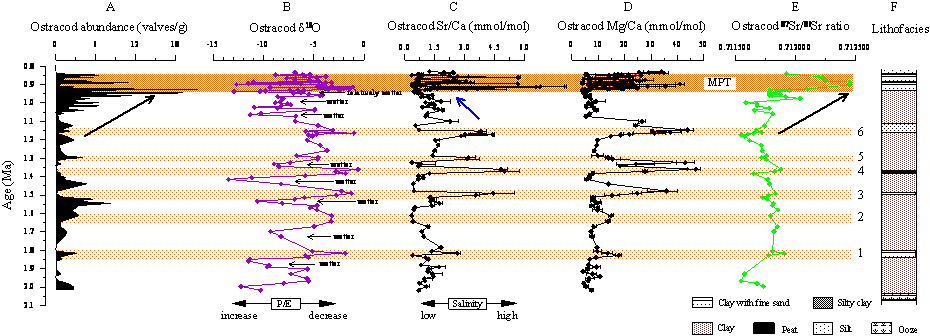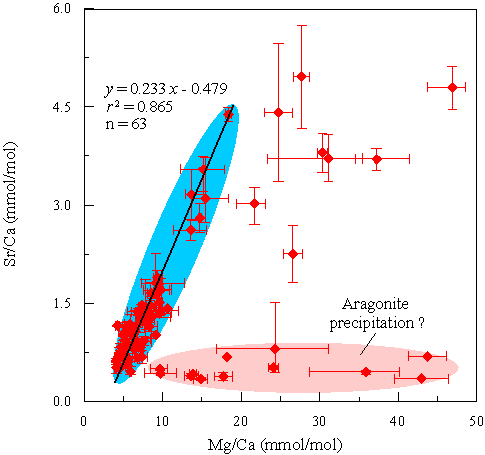
Figure 1 Variations in (A) abundance, (B) oxygen isotope (δ18O), (C) molar Sr/Ca, (D) molar Mg/Ca, (E) 87Sr/86Sr of Qinghaicypris crassa shells, and (F) sedimentological units for the 52–143 m interval of the core CE plotted against age. Shaded zones highlight the warm and/or dry climatic fluctuations (labeled Zones 1 to 6) and the mid-Pleistocene transition (MPT).Arrows mark the trend before the MPT. (Credit to Jin et al.,)

Figure 2 The relationship between the molar Mg/Ca and Sr/Ca ratios of the ostracod shells of Qinghaicypris crassa preserved in the early to mid-Pleistocene (2.01–0.95 Ma) sediments of Co Ngoin in the central Tibetan Plateau. The samples in the pink shade, probably controlled by aragonite precipitation, are excluded from regression. A stronger correlation is shown for the remaining samples with Mg/Ca<20 mmol/mol, serving to document changes in lake-water chemistry.(Credit to Jin et al.,)
The uplift of the Himalayan-Tibetan orogen has been postulated that the elevation gradient of the high mountain chain induces marked increases in physical weathering (erosion) and silicate weathering rates, which act to remove CO2 from the atmosphere. The Tibetan Plateau is the key to understanding the East Asian and Indian summer monsoons because of (i) its role in initiating and maintaining monsoon circulations and (ii) its high sensitivity to monsoon variations. One related question is how long-term chemical weathering processes respond to monsoon change.
As bivalved arthropods, the chemistry of freshwater ostracod shells provides valuable information about lake water chemistry. Due to distinct difference between the 87Sr/86Sr ratios of seawater and freshwater, the stratigraphic 87Sr/86Sr variations of ostracod fossils have been successfully used to trace the transitional marine-lacustrine environment. However, only one work has focused on ostracod 87Sr/86Sr ratios to evaluate changing conditions in a truly lacustrine or freshwater system.
Prof. Jin Zhangdong from Institute of Earth Environment, CAS and his group,collaborated with colleagues at the University of Cambridge, the Lamont-Doherty Earth Observatory of Columbia University and the Nanjing Institute of Geography & Limnology, provide the first coherent, high-resolution chemical and ostracod Sr-O isotopic records of early to mid-Pleistocene climate variations and chemical weathering processes related to changes in the Indian monsoon system from the central Tibetan Plateau. The main conclusions include:
(1) Between 2.01 and 0.95 Ma,lake water chemistry was dominated by a high proportion of carbonate weathering related to Indian monsoon variation, resulting in relatively low and constant ostracod 87Sr/86Sr but obvious fluctuations in Mg/Ca, Sr/Ca and δ18O associated with at least six mild to warm climatic cycles;
(2) The increase in ostracod 87Sr/86Sr across the mid-Pleistocene transition (MPT) highlights a change in catchment weathering patterns induced by increased glaciation and strong seasonality on the plateau, rather than in climate-enhanced weathering intensity, with an increased weathering of 87Sr-rich minerals potentially induced by marked extensive glaciation and strong seasonality in the central plateau;
(3) Across the MPT, a significant increase in 87Sr/86Sr and frequently fluctuating ratios of ostracod Mg/Ca, Sr/Ca and δ18O are coincident with increases in both Chinese loess grain size and Arabian Sea lithogenic flux. This correlation indicates an increased glaciation and a strong monsoon seasonal contrast over the plateau across the MPT. Both plants and fauna immediately responded to the MPT shift.
Related paper entitled “Ostracod Mg/Sr/Ca and 87Sr/86Sr geochemistry from Tibetan lake sediments: Implications for early to mid-Pleistocene Indian monsoon and catchment weathering” by Jin Z D, Bickle M J, Chapman H J, et al. is in press in the Boreas.
 © 2015 Institute of Earth Environment,CAS
© 2015 Institute of Earth Environment,CAS Address:No. 97 Yanxiang Road, Xi'an 710061, Shaanxi, China

 Location :
Location :